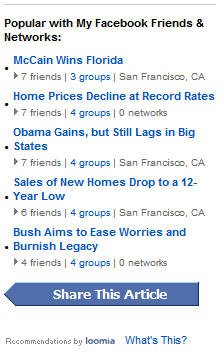Recommendations engine Loomia has signed deals with the Wall Street Journal, CNET, and NBC to provide users of those companies’ news websites with recommendations based on what their Facebook friends are reading.
2

Readers of these publications who are also Facebook users with Loomia’s SeenThis? application installed will see a list of recommended news articles like the one seen to the right. These recommendations are in addition to the ones typically made by the news sites, and they are derived completely from what your other SeenThis?-using friends on Facebook have been reading on the site. The so-called “social annotation line” below each headline gives users a sense of how the recommendation was generated.
Loomia co-founder and CTO David Marks says that there are several factors that go into determining whether a recommendation should be made. Of course, a user must actually visit an article before it can be considered for recommendation, but other factors such as link clicks are also taken into consideration. If a user explicitly shares an item on Facebook through Loomia, the behavior will show the strongest preference for an item. As for how the system decides which of your friends’ articles are most appropriate to show you, SeenThis? considers which Facebook groups and networks you are part of, in addition to which articles you have read personally.
Sound a lot like Facebook’s own Beacon? Well that’s because it is…but it also isn’t. With Loomia, all of the data is anonymized so there is no fear of revealing your reading habits to others. Loomia’s SeenThis? system also inverts the Beacon concept by providing social recommendations outside of Facebook and on partner sites themselves, in addition to the other way around (the SeenThis? application within Facebook will let you see what your friends have been reading across Loomia’s partner sites). Finally, SeenThis? differs by focusing on news article recommendations and not purchases from places like Amazon. Don’t expect to see a scarf recommendation from Loomia while browsing Amazon anytime soon.
When pressed on whether he’s concerned that Facebook could extend Beacon’s capabilities to include off-site recommendations, Marks responded by saying that content partners actually have an incentive to work with a third party company like Loomia when integrating social recommendation features. If they were to partner with Facebook directly, they would then have to partner will every other social network individually as well. With Loomia, they need to establish only one business relationship and the SeenThis? application will then aggregate information from across all participating social networks.
Oh yea, and about that WSJ subscription wall – Facebook users will be able to read any WSJ articles recommended to them for free.
Update: Marks wanted to add to the distinctions between SeenThis? and Beacon by emphasizing that SeenThis? is not an advertisement network like Beacon. Whereas with Beacon advertisers essentially pay Facebook for the opportunity to participate in the on-site “recommendations” by Facebook users, no one is paying Loomia to advertise on Facebook. He also emphasizes that 95% of SeenThis?’s usage takes place outside of Facebook, even though the application within Facebook serves as a destination for recommendations.
